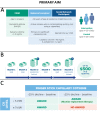Randomised pilot trial of cash incentives for reducing paediatric asthmatic tobacco smoke exposures from maternal caregivers and members of their social network
- PMID: 33004310
- PMCID: PMC7982931
- DOI: 10.1136/archdischild-2019-318352
Randomised pilot trial of cash incentives for reducing paediatric asthmatic tobacco smoke exposures from maternal caregivers and members of their social network
Abstract
Background: The primary aim was to evaluate the efficacy of financial incentives for reducing paediatric tobacco smoke exposures (TSEs) through motivating cigarette usage reduction among low-income maternal caregivers and members of their social network.
Design: Randomised control pilot trial over a 6-month study follow-up time period. The study was undertaken from May 2017 to -May 2018. Once monthly follow-up visits occurred over the 6-month study period.
Setting: Baltimore City, Maryland, USA.
Participants: We grouped 135 participants into 45 triads (asthmatic child (2-12 years of age), maternal caregiver and social network member). Triads were assigned in a 1:1 allocation ratio. The maternal caregiver and social network members were active smokers and contributed to paediatric TSE.
Interventions: Triads were randomised to receive either usual care (TSE education and quitline referrals) or usual care plus financial incentives. Cash incentives up to $1000 were earned by caregivers and designated social network participants. Incentives for either caregivers or social network participants were provided contingent on their individual reduction of tobacco usage measured by biomarkers of tobacco usage. Study visits occurred once a month during the 6-month trial.
Main outcome measures: The main outcome measure was mean change in monthly paediatric cotinine levels over 6 months of follow-up interval and was analysed on an intention-to-treat basis.
Results: The mean change in monthly child cotinine values was not significantly different in the intervention cohort over the 6-month follow-up period, compared with the control group (p=0.098, CI -0.16 to 1.89). Trends in child cotinine could not be ascribed to caregivers or social network members. Despite decreasing mean monthly cotinine values, neither the intervention cohort's caregivers (difference in slope (control-intervention)=3.30 ng/mL/month, CI -7.72 to 1.13, p=0.144) or paired social network members (difference in slope (control-intervention)=-1.59 ng/mL/month, CI -3.57 to 6.74, p=0.546) had significantly different cotinine levels than counterparts in the control group.
Conclusions: Financial incentives directed at adult contributors to paediatric TSE did not decrease child cotinine levels.
Trial registration number: NCT03099811.
Keywords: community child health; race and health; respiratory.
© Author(s) (or their employer(s)) 2021. Re-use permitted under CC BY-NC. No commercial re-use. See rights and permissions. Published by BMJ.
Conflict of interest statement
Competing interests: None declared.
Figures


